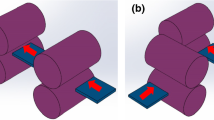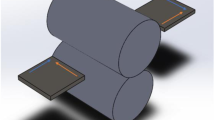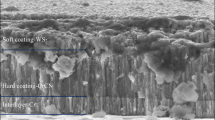Abstract.
Production of thin rotary cutting tools involves several challenges related to the maximization of uniform tensile and bending properties and levelness. This research project investigates the feasibility of manufacturing these tools through cross-rolling and austempering-tempering of a high-carbon low-alloy steel. In this regard, the combination of the new deformation process and austempering-tempering was compared to a commercial circular saw blade made by conventional hot rolling followed by quenching and tempering. The results reveal that the cross-rolled austempered materials show higher resistance to tempering. They also show that the combination of cross-rolling and austempering-tempering results in higher: hardness (9%), yield stress (YS) (19%), UTS (%19), and bending strength (BS) (22%), while maintaining similar ductility when compared to the quenched and tempered material. The reason for such an improvement is related to the presence of homogeneous α and ε fiber textures in combination with a microstructure made of lower bainite. Tempering of bainite close to the bainitic transformation temperature range permitted to adjust strength/ductility and maximize the levelness of the final product. The novel manufacturing approach proposed enables the production of thinner rotary tools that minimize waste during the cutting operation.
Access provided by Autonomous University of Puebla. Download conference paper PDF
Similar content being viewed by others
Keywords:
1 Introduction
Cross-rolling reduces the asymmetry of the mechanical properties along rolling (RD) and transverse direction (TD) by changing the slip systems and the Schmid factor [1]. Narayanswamy et al. [2] observed that cross-rolling strengthens the {100}<110> texture of α fiber in the deformed sheets. Austempering (AUST) near the Ms temperature is reported to generate fine lower bainite and retained austenite (RA) having ultra-high strength (>2 GPa) and considerable toughness [3, 4]. The previous studies revealed that the original microstructure of the low-temperature bainite is retained during tempering [5, 6]. This phenomenon is more distinct for high-carbon steels [6]. The rotary tool-like circular saws used for guided sawing applications should have excellent isotropic mechanical properties and perfect levelness [7]. The present study investigates the feasibility of manufacturing high-performance circular saws through cross-rolling and austempering-tempering (AUST-T).
2 Materials and Methods
High-carbon low-alloy steel plates (Fe- 0.70C- 0.60Si- 0.54Mn- 0.40Cr- 0.73Ni- 0.069Mo- 0.28Al (wt.%)) were cold-rolled to reduce their thickness from 5.3 to 2 mm (62% reduction). For one series of specimens, unidirectional-rolling (UR) was performed, while for the second one, cross-rolling (CR) was achieved by rotating the specimens by 90° after each pass. The Ms and Bs temperatures were calculated at 222 and 397 °C, respectively, using the MUCG83 software [8]. The sheets were austenitized at 860 °C for 30 minutes, followed by austempering at 250 °C for 1 hour. The austempered materials were clamp tempered at 400 °C for 2 hours. The microstructure and texture evolution were characterized through OM, FESEM, XRD, EDS, and EBSD. The hardness, tensile, and flexural properties were also measured and compared to a commercial saw manufactured from the same material through the quench and tempering (Q-T) process.
3 Results and Discussion
Figure 1 shows the microstructure of the CR AUST and AUST-T materials. AUST develops lath-like bainite and filmy RA (Fig. 1a). Tempering causes the coarsening of the microstructure and decomposition of RA to bainitic ferrite and carbide. The remaining RA is characterized by blocky and filmy morphology (Fig. 1b). Transformation-induced plasticity (TRIP) after AUST results in an ultra-high strength in the materials (Table 1). The CR samples showed higher resistance to softening than unidirectionally UR sheets during tempering (Table 1).
UR developed the <110>//RD and <111>//ND fibers and CR induced distinct {100}<110> texture of α and ε fibers (Fig. 2). The {100}<110> component of CR samples retained after AUST-T (Fig. 2). These components locate on the high-density 110 planes resulting in uniform tensile behavior along perpendicular directions. However, UR sheets only have ductile behavior along RD. The intense texture of CR samples showed higher resistance to softening during tempering (Table 1).
4 Conclusions
Based on the above research, it can be concluded that: (1) AUST-T results in a bainitic microstructure with an excellent strength/ductility balance. (2) CR generates distinct uniform {100}<110> texture, increasing material resistance to softening. (3) Production of thinner rotary tools with the same material is possible with CR and AUST-T.
References
Amininejad A, et al. Improvement of strength-ductility balance of SAE 304 stainless steel by asymmetric cross rolling. Mater Chem Phys. 2020;256:123668. https://doi.org/10.1016/j.matchemphys.2020.123668.
Narayanswamy S, et al. Cross-rolling mediated microstructure and texture evolution in severely cold-rolled and annealed ultrafine pearlite. Mater Charact. 2021;171:110751. https://doi.org/10.1016/j.matchar.2020.110751.
Zhao L, et al. The combining effects of ausforming and below-Ms or above-Ms austempering on the transformation kinetics, microstructure and mechanical properties of low-carbon bainitic steel. Mater Des. 2019;183:108123. https://doi.org/10.1016/j.matdes.2019.108123.
Jo M, et al. Enhancement of ballistic performance enabled bytransformation-induced plasticity in high-strength bainitic steel. J Mater Sci Technol. 2021;84:219–29. https://doi.org/10.1016/j.jmst.2020.12.059.
Chen K, et al. Enhanced mechanical properties by retained austenite in medium–carbon Si-rich microalloyed steel treated by quenching–tempering, austempering and austempering–tempering processes. Mater Sci Eng A. 2020;790:139742. https://doi.org/10.1016/j.msea.2020.139742.
Wang F, et al. Tempering response and improved mechanical properties in secondary hardened steel by introducing an optimized austempering process. Mater Sci Eng A. 2021;807:140895. https://doi.org/10.1016/j.msea.2021.140895.
Khorasany RMH, et al. Vibration characteristics of guided circular saws: experimental and numerical analyses. J Vib Acoust. 2012;134(6):061004. https://doi.org/10.1115/1.4006650.
Peet M, Bhadeshia HKDH. University of Cambridge, Cambridge, UK. https://www.phase-trans.msm.cam.ac.uk/map/steel/programs/mucg83.html. Last accessed 2022/4/4.
Acknowledgments
The authors acknowledge the FPInnovations and the Natural Sciences and Engineering Research Council of Canada (NSERC) for providing financial support (grant #CRDPJ 518967-17).
Author information
Authors and Affiliations
Corresponding author
Editor information
Editors and Affiliations
Rights and permissions
Copyright information
© 2023 The Author(s), under exclusive license to Springer Nature Switzerland AG
About this paper
Cite this paper
M. Shirazi, H., Georges, R., Ugulino, B., Hernández, R., Blais, C. (2023). Fabrication of Thin Rotary Tools Through a Combination of Cross-Rolling and Austempering-Tempering. In: Proceedings of the 61st Conference of Metallurgists, COM 2022. COM 2022. Springer, Cham. https://doi.org/10.1007/978-3-031-17425-4_4
Download citation
DOI: https://doi.org/10.1007/978-3-031-17425-4_4
Published:
Publisher Name: Springer, Cham
Print ISBN: 978-3-031-17424-7
Online ISBN: 978-3-031-17425-4
eBook Packages: Chemistry and Materials ScienceChemistry and Material Science (R0)






